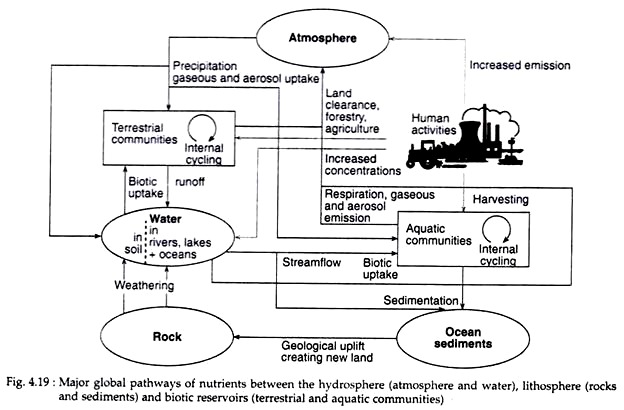In this article we will discuss about the biogeochemical cycle.
The protoplasm of the living world requires a number of essential elements. These chemical elements move from the abiotic to the biotic portion of the ecosystem through the plants which take up carbon dioxide from the air and water and minerals from the soil or water bodies.
They are then passed on to the consumers. These nutrients are returned to the abiotic portion of the ecosystem through excretory processes of producers, consumers and decomposers.
Thus, unlike the linear or one way energy transfer, the pattern of nutrient transfer is basically circular or cyclic. These more or less circular pathways of nutrients are known as biogeochemical cycles (bio refers to living organisms and geo to earth).
ADVERTISEMENTS:
Fig. 4.19 shows the biogeochemical cycle of nutrients between the hydrosphere (atmosphere and water), lithosphere (rocks and sediments) and the terrestrial and aquatic communities.
The movement of these elements essential to life is also designated as nutrient cycling.
The nutrient cycle can be divided into two pools:
ADVERTISEMENTS:
(1) The reservoir pool, which is the large, slow-moving non-biological component, and
(2) The cycling or labile pool, which is a small but active portion that is exchanged between the organisms and their environment.
The chemical composition of earth and the exchange of elements between the atmosphere and the oceans, rivers, and other water bodies are referred to as geochemistry. Biogeochemistry refers to the study of the exchange of materials between living and nonliving components of the ecosphere.
The principles of biogeochemical cycle can be illustrated through five examples:
ADVERTISEMENTS:
(1) Nitrogen cycle—which is an example of a very complex, well-buffered, gaseous-type cycle.
(2) Phosphorus cycle—which is an example of a simpler, less well-buffered, regulated cycle.
(3) Sulfur cycle that illustrates the links between air, water and the crust of earth, the key role played by microorganisms and the complications caused by industrial air pollution.
(4) Carbon cycle.
(5) Hydrologic cycle—which are crucial to life and are being increasingly affected by the activities of human beings. Here we would be discussing only the nitrogen and carbon cycle.
